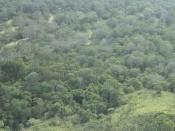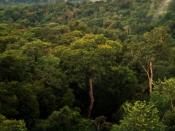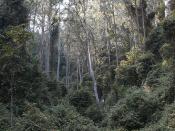Rainforests cover 2 percent of the earth's surface, or 7 percent of its land mass.
Tropical rainforests are the Earth's oldest continuous ecosystem. Fossil records show that the forests of South East Asia have existed for 70 to 100 million years.
Rainforests are being destroyed at an estimated rate of about one
football-field-sized area per second.
The soil has few nutrients so it makes poor farmland. An area of rainforest cleared for farming or grazing cattle becomes unproductive in only a few years.
Tropical rainforests are the most diverse ecosystems on earth. A four-square mile patch of rainforest contains as many as 1500 species of flowering plants, 750 species of trees, 125 species of mammals, 400 species of birds, 100 species of reptiles, 60 species of amphibians, and 150 species of butterflies.
Native rainforest plants, insects and other animals form a fragile network that cycles and returns the most nutrients possible out of the poor soil.
Tiny Panama has as many species of plants as all of Europe. Ecuador, which is about the size of Colorado, has twice as many species of birds as the United States and Canada combined.
While there are many species of plants in a square-mile of tropical rainforest, there may only be one or two of each. Removing one plant can severely damage the fragile ecosystem.
Animals are dependent on plants for food and habitat. For example, some insects can only live on one type of plant. Destroying the plant can cause the insect to become extinct.
The indigenous people of the tropical rainforests are the greatest source of knowledge about medicines from rainforest plants. These people have traditionally passed their knowledge on to their children. But this is changing as children are choosing not to follow in their ancestors' footsteps.
One of the major...


